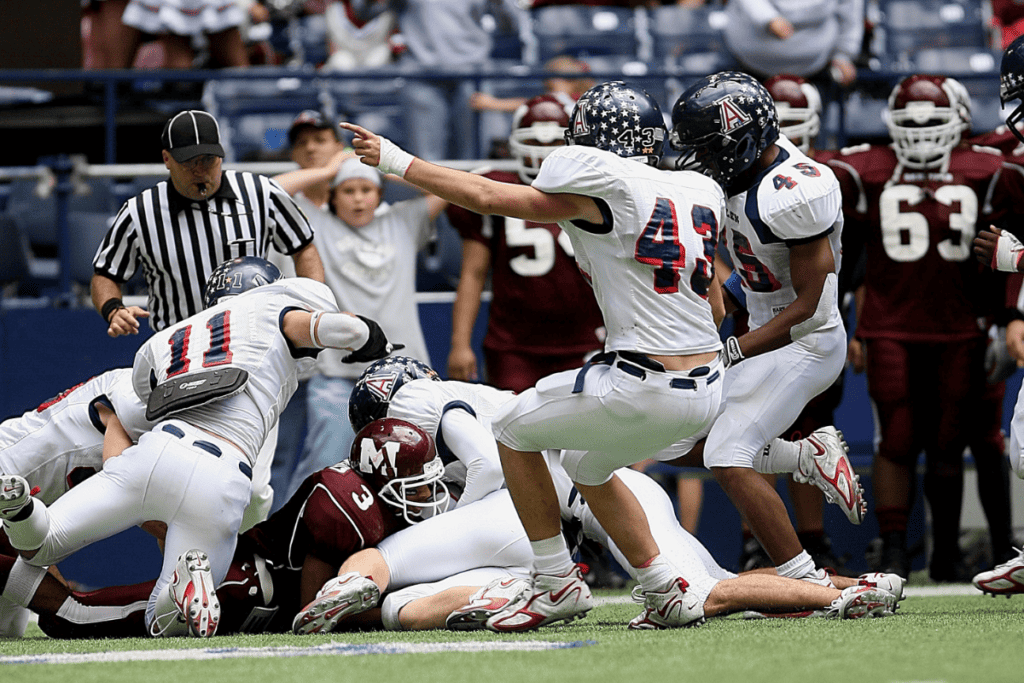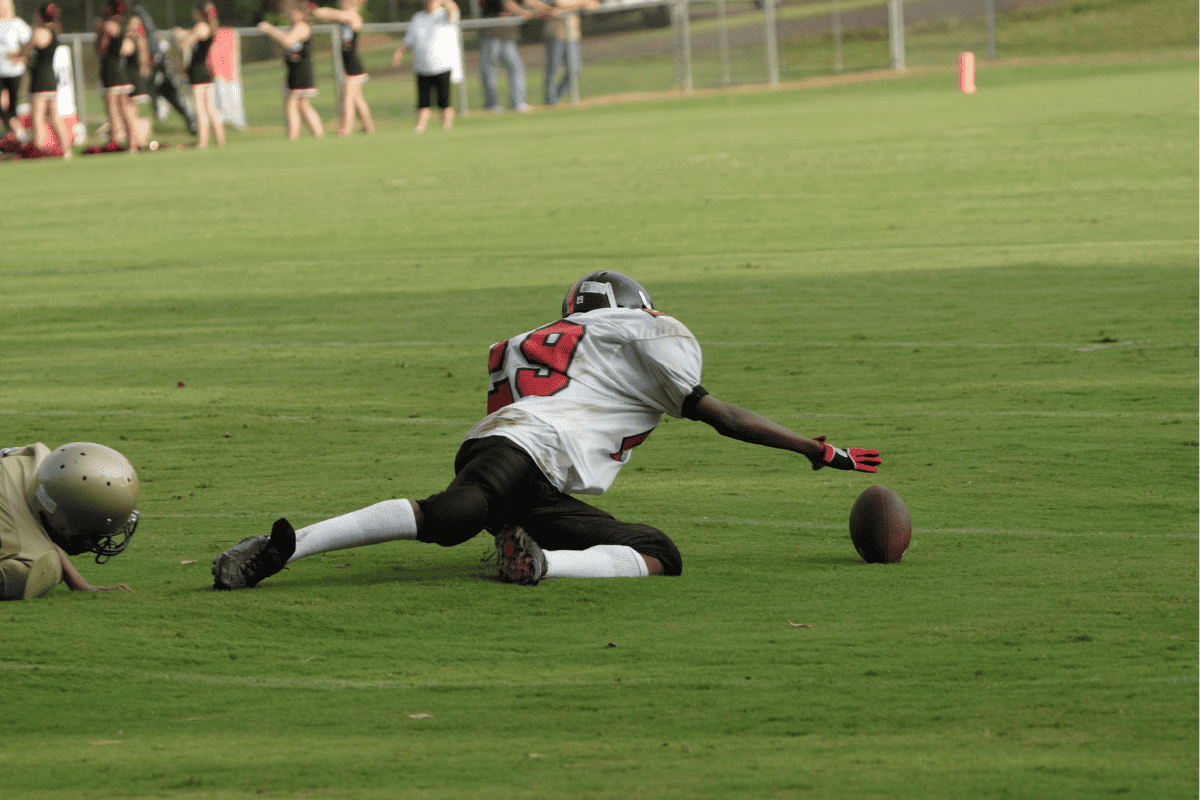What is a Fumble in Football (A Beginner’s Guide)
Welcome to the thrilling game of football, a sport where strategy, skill, and sometimes, a bit of luck intertwine to create moments of high drama. One such moment, often a game-changer, is the fumble.
A fumble can turn the tide of a game, shifting momentum from one team to another in a matter of seconds. For those new to football, knowing what a fumble is and how it occurs is crucial.
This article delves into the nitty-gritty of fumbles, from their definition to the dramatic impact they can have on a game. So, whether you’re a seasoned fan or a curious newcomer, let’s unpack the exciting and sometimes chaotic world of fumbles in football!
Defining a Fumble
In football, a fumble is when a player who has possession and control of the ball loses it before being downed or scoring. It’s a kind of turnover, meaning the ball changes hands from the offense to the defense, though not every fumble results in a turnover.
The key here is the loss of control before the player is downed – either by knee, elbow, or other body parts touching the ground. Unlike an interception, where the ball is caught directly from the air by an opponent, a fumble involves losing physical possession of the ball while in play.
Fumbles can occur due to various reasons – a strong tackle, a mishandled handoff, or even a player’s own mistake.
How Does a Fumble Occur?
A fumble can happen in several ways, but it always involves the ball carrier losing possession. Here are some common scenarios:
- Tackles: The most common cause. A defensive player hits the ball carrier, jarring the ball loose.
- Strip: A defender deliberately pulls or punches the ball out of the carrier’s hands.
- Mishandling: The ball carrier might simply lose grip, especially in adverse weather conditions or if they’re trying to switch the ball from one hand to another.
- Bad Exchange: During a handoff or snap, the ball might not be securely transferred, leading to a fumble.
- Collision with Teammate: Occasionally, running into a teammate can cause a fumble.
Picture this: it’s a rainy day, the quarterback snaps the ball and hands it off to the running back. As he dashes through a gap in the defense, a linebacker surges forward, delivering a powerful tackle.
The impact is so intense that the ball slips out of the running back’s grasp and tumbles onto the field. This is a classic fumble scenario – sudden, unexpected, and often turning the game’s rhythm on its head.
Recovering a Fumble
Recovering a fumble is as crucial as the fumble itself. When the ball hits the ground, it’s fair game for both teams, turning the moment into a scramble of strategy and agility.
Here’s how fumble recovery works:
- Immediate Action: Players from both sides will generally dive towards the ball. It’s a test of reflexes and awareness.
- Securing Possession: The team that recovers the ball gains possession. If the defense recovers, it’s a turnover.
- Advance or Down: On most occasions, the player who recovers the fumble can advance the ball. However, there are exceptions, like if the fumble occurs on fourth down.
A successful fumble recovery can be a game-changer.
For instance, if the offense is close to scoring but fumbles, and the defense recovers, it can prevent a sure score. On the other hand, if the offense recovers their own fumble, they retain possession, often saving the drive from a premature end.
Famous Fumbles in Football History
Fumbles have marked some of the most memorable moments in football history. Here are a few notable instances:
- The Miracle at the Meadowlands (1978): Instead of taking a knee, the Giants attempted a run play, resulting in a fumble that the Eagles recovered for a game-winning touchdown.
- Leon Lett’s Super Bowl Blunder (1993): In Super Bowl XXVII, Lett, celebrating prematurely, fumbled near the goal line, preventing a certain touchdown.
- The Tuck Rule Game (2001): A controversial play where a potential fumble by Tom Brady was ruled an incomplete pass, significantly impacting the game and sparking widespread debate.
These instances underscore the unpredictable nature of fumbles and their ability to etch moments into football lore.
Fumbles and Game Strategy

Fumbles significantly influence team strategies, both offensively and defensively.
- Offensive Strategy: Ball security is paramount. Coaches train players, especially quarterbacks and running backs, to hold the ball securely, reducing the risk of fumbles. In high-pressure situations, teams might opt for safer plays to minimize the risk of turnovers.
- Defensive Strategy: Defenses practice stripping the ball and pouncing on loose balls. A well-timed strip or hit can force a fumble, turning the defense into an offensive opportunity. For a defense, a forced fumble is not just about stopping the play; it’s about creating a chance to score or gain advantageous field position.
Understanding fumbles and their implications is essential for both players and fans. They add an element of unpredictability to the game, making football not just a game of yards and points, but also one of opportunities and swift changes in fortune.
Fumbles in Player Statistics
Fumbles can have a significant impact on a player’s statistics and, by extension, their reputation.
Here’s how they are typically recorded and viewed:
- Recording Fumbles: Fumbles are tracked as individual statistics for both offensive and defensive players. For offensive players, it’s the number of times they lose the ball. For defensive players, it’s the number of times they’ve forced a fumble.
- Impact on Reputation: A high number of fumbles can be detrimental to a player’s career, especially for key positions like quarterbacks and running backs. It can be seen as a sign of unreliability or poor ball-handling skills.
- Recovery Stats: The number of fumbles recovered by a player is also tracked. This stat is particularly important for defensive players, as it highlights their ability to capitalize on turnovers.
Fumbles in player statistics aren’t just numbers; they tell a story about a player’s performance under pressure and their contribution to the team’s success.
Conclusion
Fumbles, with their unpredictability and potential for dramatic shifts in the game’s momentum, are one of the most exciting aspects of football. They test the skills and reflexes of both offense and defense, creating moments that can become pivotal turning points in a game.
Understanding fumbles, from their basic definition to their strategic implications, enriches the experience of watching and appreciating football. As you watch your next game, keep an eye out for these crucial moments – they might just be the key to victory or defeat.
Fumble FAQs
Q: What exactly is a fumble in football?
A: A fumble occurs when a player who has possession and control of the ball loses it before they are downed or score.
Q: Can a fumbled ball be advanced by the recovering team?
A: Yes, in most cases, the player who recovers the fumble can advance the ball unless specific rules prevent it, like on a fourth-down fumble.
Q: How does a fumble differ from an interception?
A: A fumble is the loss of possession of a ball in play, while an interception is a pass caught by a defensive player, stopping the offensive play.
Q: Are there any specific drills to prevent fumbles?
A: Yes, players practice drills that focus on ball security, like high-and-tight drills for carrying the ball securely.
Q: What impact do fumbles have on a player’s career?
A: Frequent fumbles can negatively impact a player’s reputation, especially if they play in a position where ball security is crucial.
Q: Can both teams recover a fumble?
A: Absolutely. Once the ball is fumbled, it’s up for grabs by either team, making quick reactions and awareness crucial.

